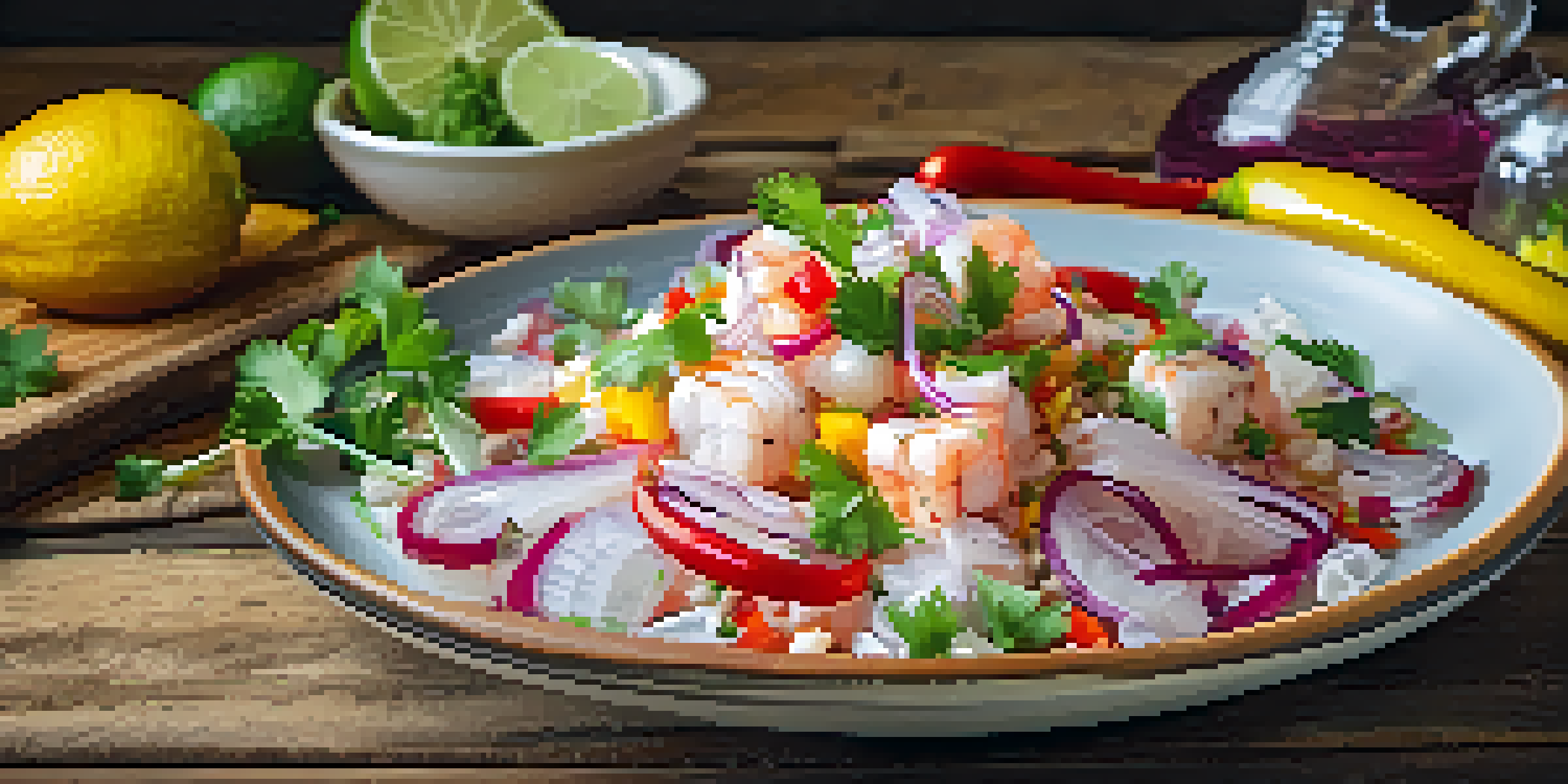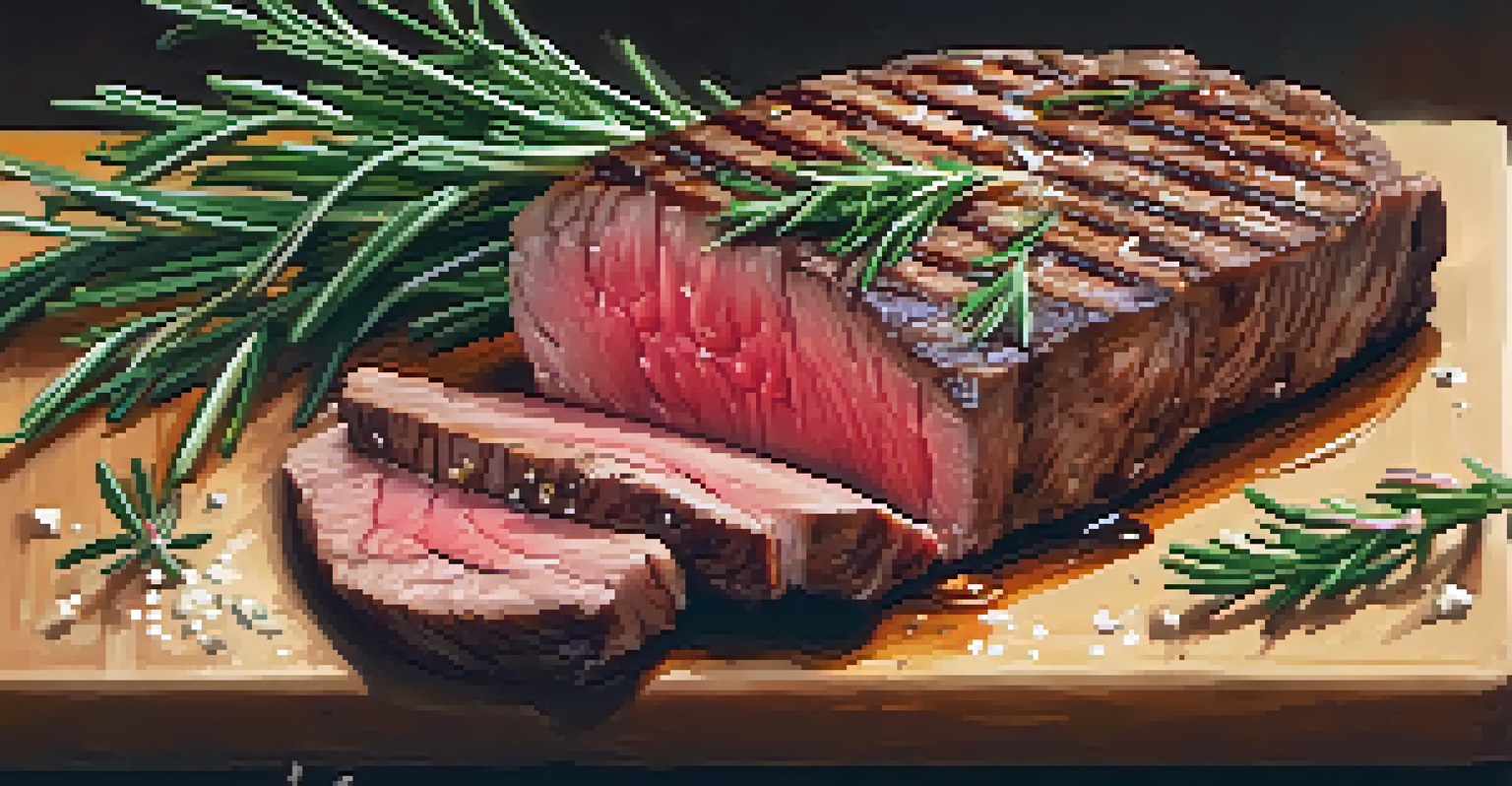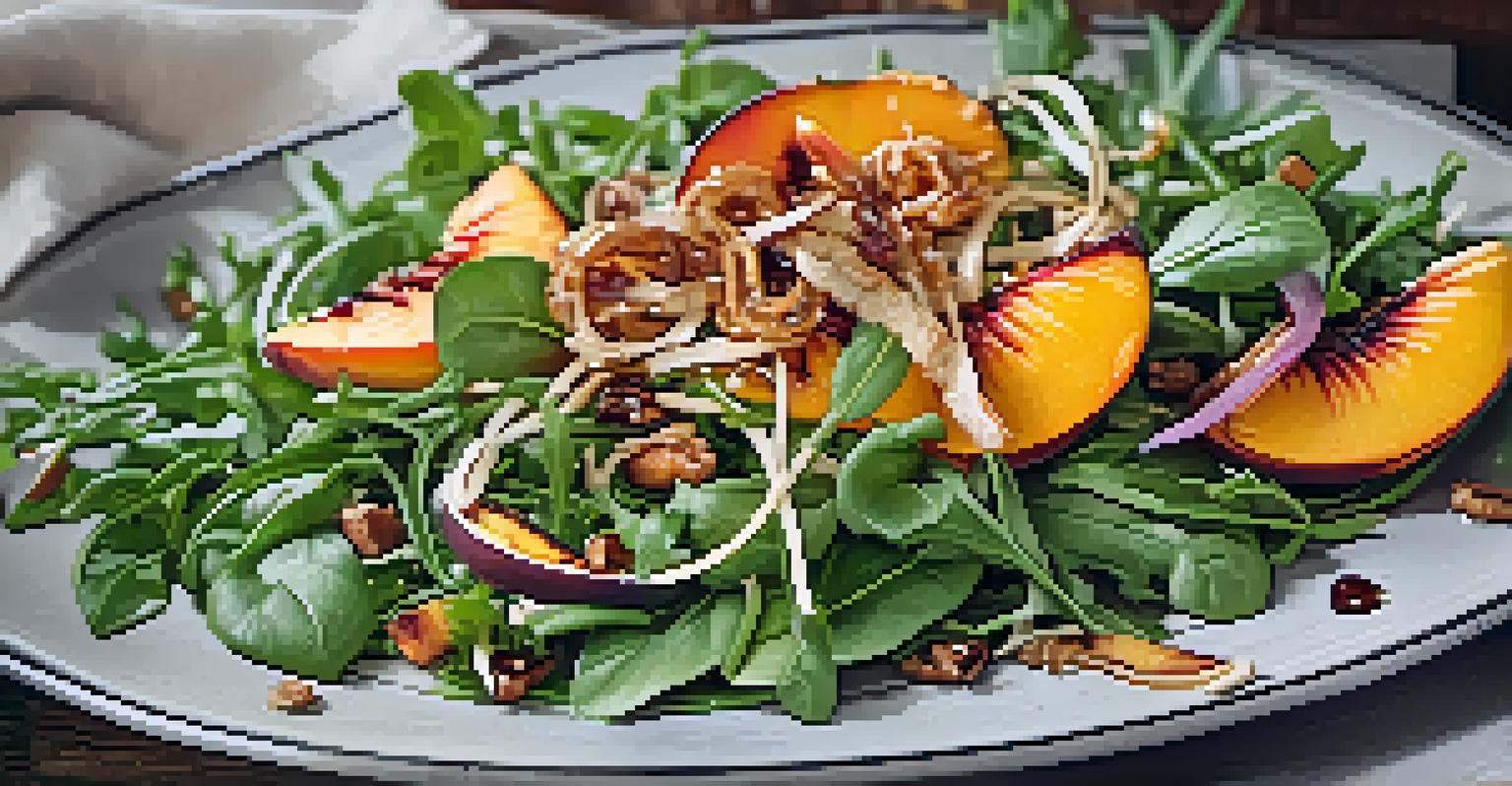The Fusion of Raw and Cooked: Culinary Innovations

Understanding Raw and Cooked Ingredients in Cuisine
The world of culinary arts has always embraced both raw and cooked ingredients, each offering unique flavors and textures. Raw foods, such as fresh vegetables and sashimi, provide a vibrant, crisp taste that often retains more nutrients. On the other hand, cooking techniques like roasting or grilling can enhance flavors, making them richer and more complex. This duality invites chefs to experiment and create innovative dishes that celebrate both worlds.
Cooking is like love. It should be entered into with abandon or not at all.
Think of it like a painting: raw ingredients are the bright colors on the palette, while cooking techniques are the brushstrokes that bring those colors to life. Chefs often find that combining these two approaches can lead to exciting new flavors, creating a dish that is both refreshing and comforting at the same time. This fusion not only tantalizes the taste buds but also challenges traditional cooking norms.
As we explore this topic, we will delve into how culinary innovations are bridging the gap between raw and cooked, showcasing the artistry and science that define modern gastronomy. From the rise of ceviche to the popularity of sous-vide cooking, the culinary landscape is evolving, making room for this exciting fusion.
The Rise of Ceviche: A Perfect Example of Fusion Cuisine
Ceviche is a fantastic illustration of how raw and cooked elements can coexist beautifully. Originating from Peru, this dish typically features fresh, raw fish marinated in citrus juices, which 'cooks' the fish through a process called denaturation. This unique method allows the flavors of the fish to shine, while the acidity of the lime or lemon juice adds a zesty kick that elevates the dish.

Imagine biting into a tender piece of fish that seems to melt in your mouth, paired with the crunch of fresh vegetables and the heat from a spicy pepper. The interplay of textures and flavors creates a culinary experience that is refreshing and complex. Ceviche serves as a testament to the creativity of chefs who embrace raw ingredients while utilizing cooking techniques to enhance the overall experience.
Fusion of Raw and Cooked Ingredients
The interplay between raw and cooked foods enhances flavor and encourages culinary creativity.
As ceviche gains popularity worldwide, it's inspiring chefs to experiment with various proteins and marinades, pushing culinary boundaries even further. This evolution reflects a broader trend in gastronomy where the fusion of raw and cooked ingredients is celebrated, leading to innovative dishes that delight diners.
Sous-Vide Cooking: A Modern Twist on Traditional Techniques
Sous-vide, which means 'under vacuum' in French, is a cooking method that involves sealing food in a bag and immersing it in a water bath at a precise temperature. This technique allows for even cooking without the risk of overcooking, preserving the moisture and flavor of the ingredients. By carefully controlling the cooking process, chefs can achieve results that are both tender and full of flavor, bridging the gap between raw and cooked.
Food is our common ground, a universal experience.
Picture a perfectly cooked steak that is seared for a crusty exterior while remaining juicy and tender on the inside; this is the magic of sous-vide. The technique allows chefs to infuse flavors with herbs and spices during the cooking process, creating a depth of flavor that is hard to achieve with traditional cooking methods. As sous-vide becomes more accessible, home cooks are also embracing this technique, elevating their culinary skills.
The beauty of sous-vide lies in its versatility; it can be used for meats, vegetables, and even desserts. This innovation has opened new doors for culinary creativity, merging raw and cooked elements in ways that were previously unimaginable. As chefs continue to explore this method, the possibilities for fusion cuisine are endless.
The Role of Fermentation in Culinary Fusion
Fermentation is another fascinating area where raw and cooked elements intersect. This ancient technique not only preserves food but also enhances its flavor profile, creating complex tastes that can elevate a dish. From kimchi to yogurt, fermented foods bring a unique tanginess that can complement both raw and cooked ingredients beautifully.
Imagine adding a dollop of tangy kimchi to a grilled pork dish or using fermented sauces to brighten up a fresh salad. The layers of flavor created through fermentation can transform a dish, providing depth and character that might otherwise be missing. Chefs and home cooks alike are increasingly experimenting with fermentation, recognizing its potential to create innovative flavor combinations.
Health Benefits of Food Pairing
Combining raw and cooked foods maximizes nutritional value and promotes a balanced diet.
As the popularity of fermented foods grows, so does their role in modern fusion cuisine. They serve as a bridge between raw and cooked by introducing live cultures that enhance both health benefits and taste. This trend not only contributes to a more exciting dining experience but also promotes sustainable food practices.
Creative Pairings: Raw and Cooked Ingredients Unite
In the world of culinary innovation, the beauty lies in creative pairings of raw and cooked ingredients. Chefs are constantly experimenting with combinations that surprise and delight diners. For instance, pairing crispy fried onions with a fresh salad adds texture and richness, showcasing how the two can work together harmoniously.
Consider a dish featuring grilled peaches served alongside a raw arugula salad; the warm, caramelized fruit contrasts beautifully with the peppery greens, creating a symphony of flavors. These thoughtful combinations not only enhance the dining experience but also challenge the notion of how we perceive raw and cooked foods. It's a celebration of contrast, balance, and creativity.
As diners become more adventurous, they seek out restaurants that push boundaries and offer unique experiences. This demand encourages chefs to think outside the box, leading to innovative dishes that blend raw and cooked elements in novel ways. The result is a vibrant culinary landscape where creativity knows no bounds.
Global Influences: How Cultures Shape Culinary Fusion
Culinary fusion is deeply influenced by cultural traditions and practices around the world. Different cuisines bring their own unique approaches to raw and cooked ingredients, allowing for exciting combinations that reflect diverse palates. For example, the Japanese embrace of sashimi highlights the beauty of raw fish, while Mediterranean diets often celebrate grilled vegetables and meats.
As chefs travel and explore different cultures, they bring back influences that inspire new creations. The blending of techniques and flavors leads to dishes that honor their origins while also pushing the culinary envelope. This global exchange enriches the culinary scene, encouraging chefs to experiment with varied ingredients to create something truly unique.
Culinary Innovations on the Rise
Chefs are increasingly experimenting with fusion cuisine, leading to exciting and diverse dining experiences.
The rise of fusion cuisine reflects a broader cultural appreciation for diversity and innovation. As we sample dishes from different parts of the world, we experience the joy of culinary exploration, where raw and cooked ingredients come together to create something extraordinary. This melting pot of flavors continues to shape the future of gastronomy.
Health Benefits of Combining Raw and Cooked Foods
Combining raw and cooked foods not only enhances flavor but also offers several health benefits. Raw fruits and vegetables retain more nutrients, while cooking can make certain foods easier to digest and increase their antioxidant levels. This balance allows individuals to enjoy a well-rounded diet that maximizes health benefits from both raw and cooked ingredients.
For example, pairing raw spinach with sautéed garlic and olive oil creates a dish that is not only flavorful but also packed with vitamins and minerals. The combination ensures that you receive the benefits of both raw and cooked components, making your meals more nutritious. This approach encourages mindful eating, promoting a healthier lifestyle.

As health-conscious trends continue to rise, chefs are focusing on creating dishes that are both delicious and nourishing. By thoughtfully combining raw and cooked ingredients, they can cater to the evolving preferences of diners who seek meals that support their well-being. This fusion not only satisfies cravings but also nurtures the body.
The Future of Culinary Innovations: Embracing Fusion
As we look to the future, the fusion of raw and cooked ingredients is likely to play a significant role in culinary innovations. Chefs are increasingly embracing the freedom to experiment, blending techniques and flavors that challenge traditional norms. This adventurous spirit is what drives the culinary world forward, inspiring new trends and ideas.
Imagine a restaurant menu that features dishes like grilled watermelon, served alongside a refreshing raw mint salad—a perfect example of how chefs are pushing the boundaries. As the culinary landscape evolves, we can expect to see even more creative combinations that celebrate the diversity of ingredients. This evolution reflects a broader movement towards sustainability and global influences in cooking.
Ultimately, the fusion of raw and cooked is more than just a trend; it's a celebration of culinary artistry and innovation. As chefs continue to explore and redefine what it means to create delicious food, diners will benefit from an ever-expanding array of flavors and experiences. The future is bright for fusion cuisine, and we can't wait to see what delicious surprises await.